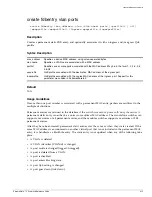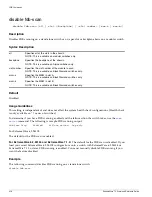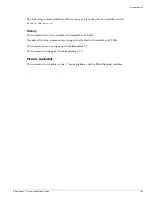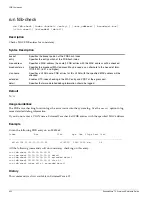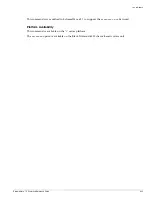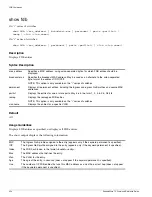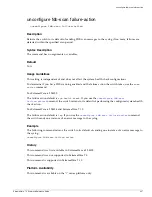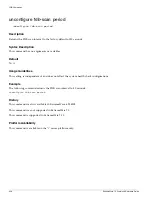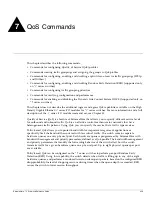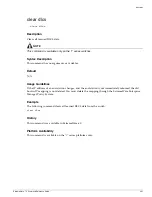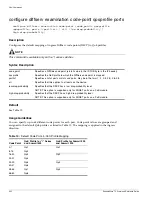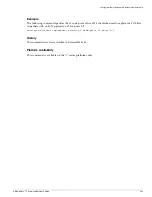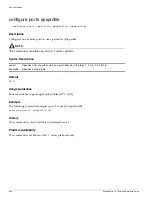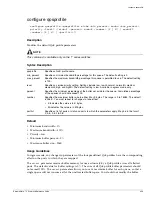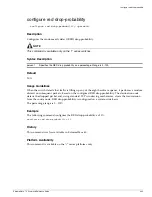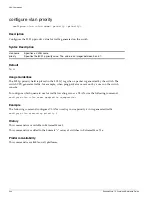
ExtremeWare 7.5 Command Reference Guide
429
7
QoS Commands
This chapter describes the following commands:
•
Commands for configuring Quality of Service (QoS) profiles
•
Commands creating traffic groupings and assigning the groups to QoS profiles
•
Commands for configuring, enabling and disabling explicit class-of-service traffic groupings (802.1p
and DiffServ)
•
Commands for configuring, enabling and disabling Random Early Detection (RED) (supported only
on “
i
” series switches)
•
Commands for configuring traffic grouping priorities
•
Commands for verifying configuration and performance
•
Commands for enabling and disabling the Dynamic Link Context System (DLCS) (supported only on
“
i
” series switches)
This chapter does not describe the additional ingress and egress QoS capabilities available on the High
Density Gigabit Ethernet
“3”
series I/O modules for
“i”
series switches. For more information and a full
description of the
“3”
series I/O module command set, see Chapter 30.
Qualify of Service (QoS) is a feature of ExtremeWare that allows you to specify different service levels
for outbound and inbound traffic. QoS is an effective control mechanism for networks that have
heterogeneous traffic patterns. Using QoS, you can specify the service that a traffic type receives.
Policy-based QoS allows you to protect bandwidth for important categories of applications or
specifically limit the bandwidth associated with less critical traffic. The switch contains separate
hardware queues on every physical port. Each hardware queue is programmed by ExtremeWare with
bandwidth management and priority parameters, defined as a QoS profile. The bandwidth management
and priority parameters that modify the forwarding behavior of the switch affect how the switch
transmits traffic for a given hardware queue on a physical port. Up to eight physical queues per port
are available.
Policy-based QoS can be configured on the “
i
” series switches to perform per-port Random Early
Detection (RED). Using this capability, the switch detects when traffic is filling up in any of the eight
hardware queues, and performs a random discard on subsequent packets, based on the configured RED
drop-probability. Instead of dropping sessions during times when the queue depth is exceeded, RED
causes the switch to lower session throughput.
Summary of Contents for ExtremeWare 7.5
Page 402: ...402 ExtremeWare 7 5 Command Reference Guide VLAN Commands ...
Page 470: ...470 ExtremeWare 7 5 Command Reference Guide QoS Commands ...
Page 490: ...490 ExtremeWare 7 5 Command Reference Guide NAT Commands ...
Page 826: ...826 ExtremeWare 7 5 Command Reference Guide Commands for Status Monitoring and Statistics ...
Page 1090: ...1090 ExtremeWare 7 5 Command Reference Guide Security Commands ...
Page 1386: ...1386 ExtremeWare 7 5 Command Reference Guide Wireless Commands ...
Page 1436: ...1436 ExtremeWare 7 5 Command Reference Guide EAPS Commands ...
Page 1568: ...1568 ExtremeWare 7 5 Command Reference Guide ESRP Commands ...
Page 1844: ...1844 ExtremeWare 7 5 Command Reference Guide IGP Commands ...
Page 1930: ...1930 ExtremeWare 7 5 Command Reference Guide BGP Commands i Series Switches Only ...
Page 2022: ...2022 ExtremeWare 7 5 Command Reference Guide IP Multicast Commands ...
Page 2066: ...2066 ExtremeWare 7 5 Command Reference Guide IPX Commands i Series Platforms Only ...
Page 2082: ...2082 ExtremeWare 7 5 Command Reference Guide ARM Commands BlackDiamond Switch Only ...
Page 2094: ...2094 ExtremeWare 7 5 Command Reference Guide Remote Connect Commands ...
Page 2174: ...2174 ExtremeWare 7 5 Command Reference Guide PoS Commands BlackDiamond Switch Only ...
Page 2372: ...2372 ExtremeWare 7 5 Command Reference Guide LLDP Commands ...
Page 2422: ...2422 ExtremeWare 7 5 Command Reference Guide H VPLS Commands BlackDiamond Switch Only ...
Page 2528: ...2528 ExtremeWare 7 5 Command Reference Guide MPLS Commands BlackDiamond Switch Only ...

